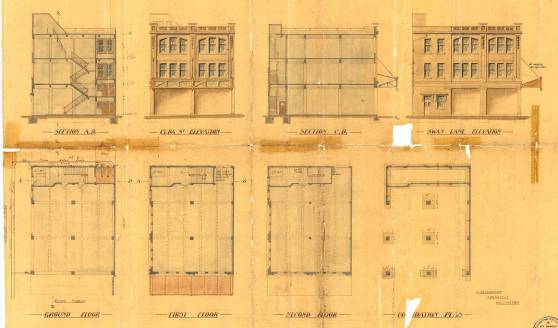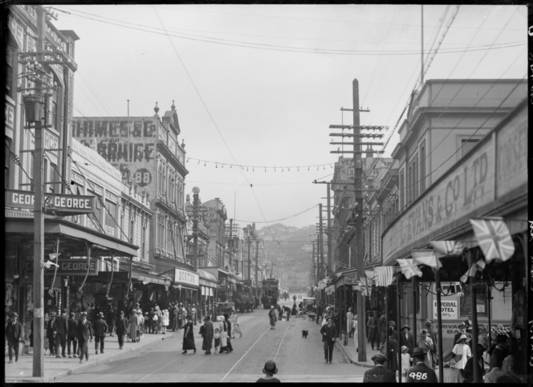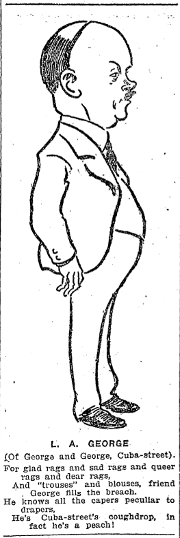George & George Building (Former)
Craft Village, Floriditas, Commercial Building; 161 Cuba Street


Image: WCC - Charles Collins, 2014

Photo: WCC - Charles Collins, 2014


Detail from JM Dawson’s 1911 plans (WC Archives 00053:166:9142)

National Library reference: Cuba Street, Wellington. Smith, Sydney Charles, 1888-1972 :Photographs of New Zealand. Ref: 1/2-048557-G. Alexander Turnbull Library, Wellington, New Zealand. http://natlib.govt.nz/records/22707136

-
Constructed
1911 - 1912
-
Heritage Area
-
Architect(s)
-
Builder(s)
Trevor Brothers
-
This building is a representative example of an Edwardian masonry commercial building in a sparsely detailed neo-Classical style. The Cuba Street and Swan Lane facades of the building remain largely unchanged with a high level of original detailing.
Designed by notable Wellington architect JM Dawson for prominent Wellington businessman and benefactor TG Macarthy.
This building has historic value for its long use as a drapery (about 50 years), in particular as the head store of George and George, a very successful Wellington drapery business.
Occupies a prominent position on the corner of Cuba Street and Swan Lane. The scale, materials and style of this building contribute to the townscape of Cuba Street.This building is part of a group of Edwardian commercial buildings on Cuba Street which contributes positively to the Cuba Street Heritage Area.
-
Downloadable(s)
-
close
History
-
This building was designed by Wellington architects, King and Dawson, for TG Macarthy. The builders were Trevor Brothers, and the permit was issued in September 1911, less than a year before Macarthy’s death.
The plans of this three-storey building show the ground floor as a single shop space, with the two upper floors similarly un-partitioned.
In October 1912 the Evening Post reported that the building, which had not been occupied since it was built, was to be taken by George and George, drapers. The article stated that JM Dawson, by then the architect to the Macarthy Estate, had drawn up plans for a two storey addition at the back (however this was later changed to three storeys). Various retail departments were to occupy the building, except the top floor which was reserved for workrooms.
The building was a drapery for about 50 years. George and George began business in Newtown in 1902. 161-163 Cuba Street became the company’s head store and by 1916 they had branches in Brooklyn, Hataitai, Petone and Newtown. George and George occupied the building until the 1960s. The building continued as a drapery, with City Markets taking on the lease. After this time the building was occupied by a number of different manufacturers and businesses. In 2002 the ground floor was fitted out for ‘Floriditas’ restaurant.
-
Modifications
close
-
1911
-
Construction (00053:166:9142)
-
1912
-
Extension to building - Additions to the rear of the building along Swan Lane. The extension was originally planned to be a two storey extension facing onto Swan Lane. This was altered to three storeys instead (00053:171:9448).
-
1927
-
New verandah (00056:40:B3946)
-
1934
-
Renovations and alterations(00056:145:B13036)
-
1955
-
New lift shaft and pent house extension (00056:521:B38797)
-
1962
-
Ground floor shop alterations (00058:234:C10495)
-
1964
-
Fire escape (00058:340:C14617)
-
1965
-
Storeroom added to rear (00058:413:C17672)
-
1966
-
Building alterations (00058:476:C20498)
-
2002
-
Interior fit-out for restaurant (00078:1071:86685)
-
2005
-
Additions and alterations, ground floor. Re-plumbing of new counter; removal of partition in front of chillers near front door (00078:1411:124776)
-
-
Occupation History
close
-
1915 - 1955
-
George & George, drapers (Stones 1915-16, 1920, 1925, 1930, 1935, 1940, 1945, Wises 1950-51, 1955)
-
1961 - 1962
-
City Markets, drapers (Wises 1961-62).
-
1960
-
From 1960s occupied by a number of manufacturers and businesses.
-
1967 - 1972
-
Roberston & Son Ltd, manufacturers' agents (1st fl (Wises 1967-68,1971-72)
-
1967 - 1972
-
Merson Industries Ltd, soft goods manufacturers (1st fl (Wises 1967-68, 1971-72)
-
1967 - 1972
-
Weigel Patterns (NZ Ltd, dress patterns (1st fl (Wises 1967-68, 1971-72)
-
1967 - 1972
-
Armstrong & Springhail Ltd, office supplies (gd fl (Wises 1967-68, 1971-72)
-
1967 - 1972
-
Typewriters Ltd (gd fl (Wises 1967-68,1971-72)
-
1971 - 1975
-
Trimline Garments Ltd (2nd fl (Wises 1971-72, 1975)
-
1975 - 1980
-
Beechy & Underwood Ltd (Wises 1975, 1980)
-
1975 - 1980
-
Golden Horn (Wises 1975, 1980
-
1985 - 1990
-
Craft Village (Wises 1985, 1990
-
-
-
close
Architectural Information
-
Building Classification(s)
close
Not assessed
-
Architecture
close
This building is three storied masonry building in restrained neo-Classical style.
The Swan Lane and Cuba Street facades of the building remain basically unchanged and reveal a simple and functional design that contains minimal Classical allusions and a concern for functional requirements such as good daylighting to the upper floors. The second-floor windows are recessed under wide segmental arches and give the building something of a warehouse flavour. The facades on both levels are marked by fluted pilasters at the middle and ends. These pilasters carry a bare capital that consists of little more than stylised guttae. There is no entablature above the pilasters but a projecting cornice and balustraded parapet cap the building. This building has pleasant proportions and contributes to the Cuba Street townscape.
-
Materials
close
The construction is reinforced concrete, with concrete floors over all levels supported on steel joists.
-
Setting
close
The building occupies a prominent site on the corner of Swan Lane and Cuba Street, enhanced by the absence of a building to the north, once the site of the Swan Hotel and now a parking lot. This allows good views of the building's long north façade. The immediate area is predominantly low-rise and older in character, with the exception of two very large, modern buildings on the opposite side of Cuba Street. The building's northern elevation forms part of an enclave of built heritage centred on Swan Lane. Included in this are The Bakehouse, and the mostly intact rear elevations of several heritage buildings, specifically Toomath's Buildings on Ghuznee Street and the Berry and Lazule Buildings on Cuba Street, again highly visible because of the parking lot. The building is close to the mid-point of the Cuba Street Heritage Area in a part of the precinct that retains a high concentration of heritage buildings. The narrowness of the streets means that broader views are not easily obtained.
-
Building Classification(s)
close
-
close
Cultural Value
This building is a representative example of an Edwardian masonry commercial building in a sparsely detailed neo-Classical style. The Cuba Street and Swan Lane facades of the building remain largely unchanged with a high level of original detailing.
Designed by notable Wellington architect JM Dawson for prominent Wellington businessman and benefactor TG Macarthy.
This building has historic value for its long use as a drapery (about 50 years), in particular as the head store of George and George, a very successful Wellington drapery business.
Occupies a prominent position on the corner of Cuba Street and Swan Lane. The scale, materials and style of this building contribute to the townscape of Cuba Street.
This building is part of a group of Edwardian commercial buildings on Cuba Street which contributes positively to the Cuba Street Heritage Area.
-
Aesthetic Value
close
-
Architectural
Does the item have architectural or artistic value for characteristics that may include its design, style, era, form, scale, materials, colour, texture, patina of age, quality of space, craftsmanship, smells, and sounds?
This building is an example of a three storied Edwardian masonry building in a sparsely detailed neo-Classical style.
The Cuba Street and Swan Lane facades of the building remain largely unchanged.
-
Group
Is the item part of a group of buildings, structures, or sites that taken together have coherence because of their age, history, style, scale, materials, or use?
This building is part of a group of Edwardian commercial buildings on Cuba Street which contribute positively to the Cuba Street Heritage Area.
This building also has group value as it is one of several buildings built for TG Macarthy.
-
Townscape
Does the item have townscape value for the part it plays in defining a space or street; providing visual interest; its role as a landmark; or the contribution it makes to the character and sense of place of Wellington?
This building occupies a prominent position on the corner of Cuba Street and Swan Lane. The scale, materials and style of this building contribute to the townscape of Cuba Street.
-
-
Historic Value
close
-
Association
Is the item associated with an important person, group, or organisation?
This building was designed by notable Wellington architect JM Dawson for prominent Wellington businessman and benefactor TG Macarthy.
This building also has historic value for its long use as a drapery (about 50 years), in particular as the head store of George and George, a very successful Wellington drapery business.
-
Association
Is the item associated with an important historic event, theme, pattern, phase, or activity?
This building is associated with the strong growth and development of Cuba Street during the Edwardian period, which resulted in the building of many fine commercial buildings.
-
- Scientific Value close
-
Social Value
close
-
Identity Sense Of Place Continuity
Is the item a focus of community, regional, or national identity? Does the item contribute to sense of place or continuity?
This building is part of a group of Edwardian commercial buildings on Cuba Street which contribute to the sense of place and continuity of the Cuba Street Heritage Area.
-
-
Level of Cultural Heritage Significance
close
-
Authentic
Does the item have authenticity or integrity because it retains significant fabric from the time of its construction or from later periods when important additions or modifications were carried out?
The Cuba Street and Swan Lane facades of the building remain largely intact with a high level of original detailing, despite modifications to the ground floor shop front.
-
Local Regional National International
Is the item important for any of the above characteristics at a local, regional, national, or international level?
This building is of local importance, as it contributes to the Cuba Street Heritage Area.
-
Representative
Is the item a good example of the class it represents?
The building is representative of the architecture and history found in Cuba Street.
-
-
Local / Regional / National / International Importance
close
Not assessed
-
Aesthetic Value
close
-
close
Site Detail
-
District Plan Number
16/ 84
-
Legal Description
Lot 1 DP 7095 and Pt Sec 154 Town of Wellington
-
Heritage New Zealand Listed
2/ Historic Place 3628
-
Archaeological Site
None
-
Current Uses
unknown
-
Former Uses
unknown
-
Has building been funded
No
-
Funding Amount
Not applicable
-
Earthquake Prone Status
124 Notice
-
-
close
Additional Information
-
Sources
close
- Cyclopedia Co. Ltd, “Mr. Thomas George Macarthy”, in The Cyclopedia of New Zealand: Wellington Provincial District (Wellington: The Cyclopedia Company Limited, 1897), accessed September 5, 2012,
- Hawke, G.R. “Macarthy, Thomas George – Biography”, in the Dictionary of New Zealand Biography, Te Ara - the Encyclopedia of New Zealand, updated September 1, 2010,
- Historic Places Trust, “Dawson, Joseph McClatchie.”, Professional Biographies, accessed 4 September 2012,
- “History of the Thomas George Macarthy Trust” Public Trust website, accessed September 22, 2012,
- Kelly, Michael, and Russell Murray, Cuba Street Heritage Area Report. (Wellington City Council: Unpublished report, prepared for Plan Change 48, 2006).
- Main, William. Wellington Through a Victorian Lens (Wellington: Millwood Press, 1972).
- Wellington City Council, “161-163 Cuba Street”, Wellington Heritage Building Inventory 2001: Non-Residential Buildings. (Wellington City Council, 2001), CUBA 22.
- Wellington City Council, Cuba Street Heritage Area spreadsheet (block 4). (Wellington City Council: Unpublished report, prepared for Plan Change 48, 2006).
- Newspapers: West Coast Times, Issue 2492, 26 March 1877, Page 3
- Newspapers: Grey River Argus, Volume 21, Issue 3079, 28 June 1878, Page 2
- Newspapers: Colonist, Volume XX, Issue 2417, 11 July 1878, Page 3
- Newspapers: “Concert”, Colonist, Volume XXVI, Issue 3529, 2 August 1882, Page 3
- Newspapers: Evening Post, Volume XXXII, Issue 28, 19 June 1886, Page 2
- Newspapers: “Wellington Industrial Exhibition”, Evening Post, Volume LI, Issue 109, 8 May 1896, Page 2
- Newspapers: Dominion, Volume 6, Issue 1585, 31 October 1912, Page 3
- “Heritage building - 161 Cuba Street, Te Aro - Craft Village”. 1041-06-CUB161, Wellington City Council Records.
- Technical Documentation close
-
Footnotes
close
Not available
-
Sources
close
Last updated: 10/17/2017 3:37:44 AM
